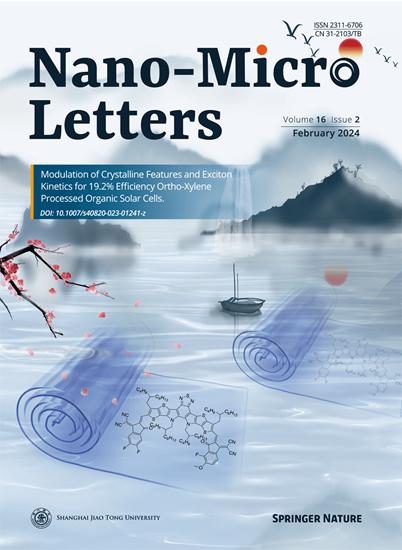A LiF-Pie-Structured Interphase for Silicon Anodes
IF 36.3
1区 材料科学
Q1 Engineering
引用次数: 0
Abstract
Article Highlights
-
A novel hierarchical solid electrolyte interface (SEI) structure is developed, featuring a lithium fluoride (LiF)-rich inner layer and a silane-based cross-linked matrix.
-
A comprehensive suite of advanced characterization techniques provides multi-scale insights into the structural and chemical composition of the LiF-Pie SEI.
-
The proposed SEI design significantly enhances cycling stability, achieving a capacity retention of LiCoO2||Si increase from 49.6% to 88.9% after 300 cycles at a current density of 100 mA g−1.
一种用于硅阳极的liff饼结构界面相。
硅(Si)具有较高的理论容量和丰度,是一种很有前途的可充电电池负极材料,但由于多孔固体-电解质界面(SEI)的不断增长,导致容量衰减,阻碍了其实际应用。本文提出了一种LiF- pie结构的SEI,将LiF纳米结构域封装在有机交联硅烷基体的内层中。低温电子显微镜、飞行时间二次离子质谱、基质辅助激光解吸/电离飞行时间质谱等一系列先进技术为界面的形成机制、纳米结构和化学组成提供了详细的见解。使用这种SEI,在100 mA g-1下循环300次后,LiCoO2||Si的容量保持率从49.6%显著提高到88.9%。这些发现提供了一种理想的界面设计原则,具有增强的(电)化学和机械稳定性,这对于维持Si阳极的功能至关重要,从而显著提高了Si基阳极的可靠性和实际应用。
本文章由计算机程序翻译,如有差异,请以英文原文为准。
求助全文
约1分钟内获得全文
求助全文
来源期刊

Nano-Micro Letters
NANOSCIENCE & NANOTECHNOLOGY-MATERIALS SCIENCE, MULTIDISCIPLINARY
CiteScore
32.60
自引率
4.90%
发文量
981
审稿时长
1.1 months
期刊介绍:
Nano-Micro Letters is a peer-reviewed, international, interdisciplinary, and open-access journal published under the SpringerOpen brand.
Nano-Micro Letters focuses on the science, experiments, engineering, technologies, and applications of nano- or microscale structures and systems in various fields such as physics, chemistry, biology, material science, and pharmacy.It also explores the expanding interfaces between these fields.
Nano-Micro Letters particularly emphasizes the bottom-up approach in the length scale from nano to micro. This approach is crucial for achieving industrial applications in nanotechnology, as it involves the assembly, modification, and control of nanostructures on a microscale.
 求助内容:
求助内容: 应助结果提醒方式:
应助结果提醒方式:


